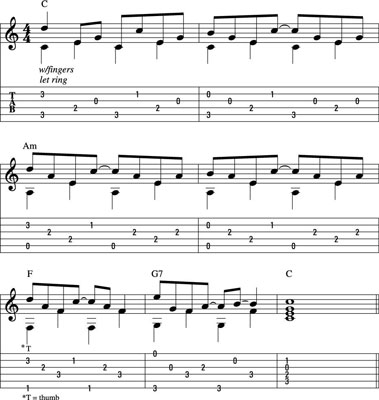Although more than 99 percent of all rock playing on the guitar is played with a pick, occasions for fingerstyle do pop up occasionally. Fingerstyle, as the name implies, means that you pluck the strings with the right-hand fingertips. For these times you can put the pick down or stick it between your teeth; whichever allows you to grab it the fastest after the fingerstyle passage is over.
Fingerstyle is especially suited to playing arpeggios, or chords played one note at a time in a given pattern. Fingerstyle is a much easier way to play different strings in rapid succession, as you must do for arpeggiated passages. Generally speaking, the thumb plays the bass strings and the fingers play the upper three strings.
Think of the opening figure to Kansas’s “Dust in the Wind,” Fleetwood Mac’s “Landslide,” or Simon and Garfunkel’s “The Boxer,” and imagine trying to play those patterns with your pick hopping frantically around the strings.
Position your right hand just above the strings, so your fingers can dangle freely but in reach of the individual strings. The thumb plays the downstem notes and the right-hand fingers play the upper notes. (For classical guitar aficionados out there: The standard way to notate the right-hand fingers is with the letters p, i, m, and a, for the Spanish words for the thumb, index, middle and ring fingers.)
A good approach is to use the index finger to play the 3rd string, the middle finger to play the 2nd string, and the ring finger to play the 1st string. Work for an even attack in the fingers and a smooth flow between the thumb and the fingers.

Of course, you don’t have to play an arpeggiated passage fingerstyle, if it’s slow and there’s relatively little string skipping involved. But for longer passages, or if the tempo is fairly rapid and the string skipping is relentless, work out the passage as a fingerstyle exercise.

